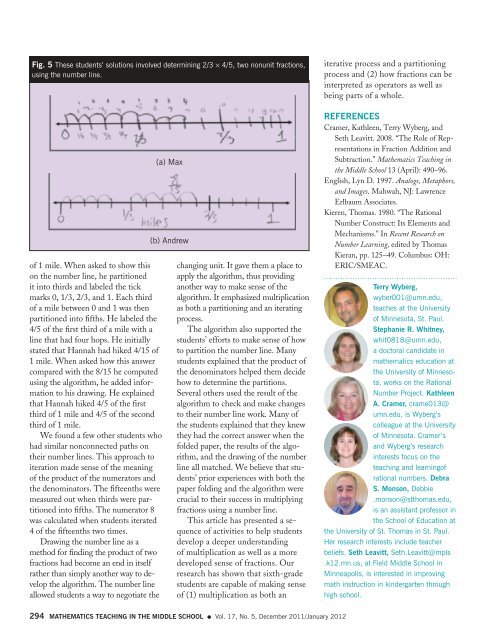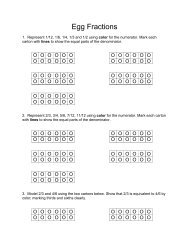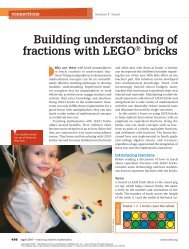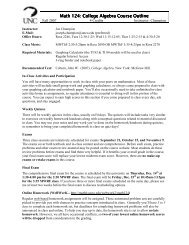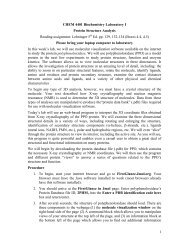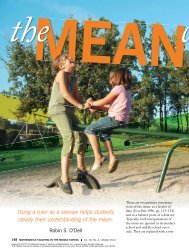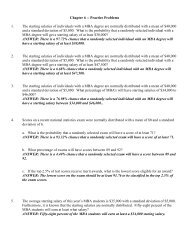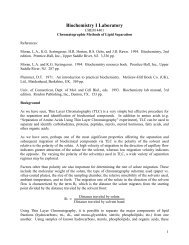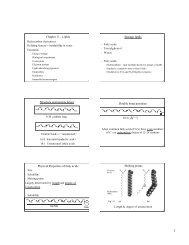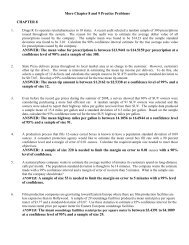Unfolding Fraction Multiplication
Unfolding Fraction Multiplication
Unfolding Fraction Multiplication
- No tags were found...
Create successful ePaper yourself
Turn your PDF publications into a flip-book with our unique Google optimized e-Paper software.
Fig. 5 These students’ solutions involved determining 2/3 × 4/5, two nonunit fractions,using the number line.of 1 mile. When asked to show thison the number line, he partitionedit into thirds and labeled the tickmarks 0, 1/3, 2/3, and 1. Each thirdof a mile between 0 and 1 was thenpartitioned into fifths. He labeled the4/5 of the first third of a mile with aline that had four hops. He initiallystated that Hannah had hiked 4/15 of1 mile. When asked how this answercompared with the 8/15 he computedusing the algorithm, he added informationto his drawing. He explainedthat Hannah hiked 4/5 of the firstthird of 1 mile and 4/5 of the secondthird of 1 mile.We found a few other students whohad similar nonconnected paths ontheir number lines. This approach toiteration made sense of the meaningof the product of the numerators andthe denominators. The fifteenths weremeasured out when thirds were partitionedinto fifths. The numerator 8was calculated when students iterated4 of the fifteenths two times.Drawing the number line as amethod for finding the product of twofractions had become an end in itselfrather than simply another way to developthe algorithm. The number lineallowed students a way to negotiate the(a) Max(b) Andrewchanging unit. It gave them a place toapply the algorithm, thus providinganother way to make sense of thealgorithm. It emphasized multiplicationas both a partitioning and an iteratingprocess.The algorithm also supported thestudents’ efforts to make sense of howto partition the number line. Manystudents explained that the product ofthe denominators helped them decidehow to determine the partitions.Several others used the result of thealgorithm to check and make changesto their number line work. Many ofthe students explained that they knewthey had the correct answer when thefolded paper, the results of the algorithm,and the drawing of the numberline all matched. We believe that students’prior experiences with both thepaper folding and the algorithm werecrucial to their success in multiplyingfractions using a number line.This article has presented a sequenceof activities to help studentsdevelop a deeper understandingof multiplication as well as a moredeveloped sense of fractions. Ourresearch has shown that sixth-gradestudents are capable of making senseof (1) multiplication as both aniterative process and a partitioningprocess and (2) how fractions can beinterpreted as operators as well asbeing parts of a whole.REFERENCESCramer, Kathleen, Terry Wyberg, andSeth Leavitt. 2008. “The Role of Representationsin <strong>Fraction</strong> Addition andSubtraction.” Mathematics Teaching inthe Middle School 13 (April): 490–96.English, Lyn D. 1997. Analogs, Metaphors,and Images. Mahwah, NJ: LawrenceErlbaum Associates.Kieren, Thomas. 1980. “The RationalNumber Construct: Its Elements andMechanisms.” In Recent Research onNumber Learning, edited by ThomasKieran, pp. 125-49. Columbus: OH:ERIC/SMEAC.Terry Wyberg,wyber001@umn.edu,teaches at the Universityof Minnesota, St. Paul.Stephanie R. Whitney,whit0818@umn.edu,a doctoral candidate inmathematics education atthe University of Minnesota,works on the RationalNumber Project. KathleenA. Cramer, crame013@umn.edu, is Wyberg’scolleague at the Universityof Minnesota. Cramer’sand Wyberg’s researchinterests focus on theteaching and learningofrational numbers. DebraS. Monson, Debbie.monson@stthomas.edu,is an assistant professor inthe School of Education atthe University of St. Thomas in St. Paul.Her research interests include teacherbeliefs. Seth Leavitt, Seth.Leavitt@mpls.k12.mn.us, at Field Middle School inMinneapolis, is interested in improvingmath instruction in kindergarten throughhigh school.294 Mathematics Teaching in the Middle School ● Vol. 17, No. 5, December 2011/January 2012


